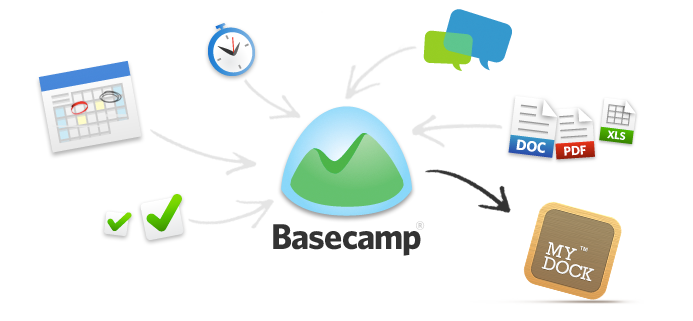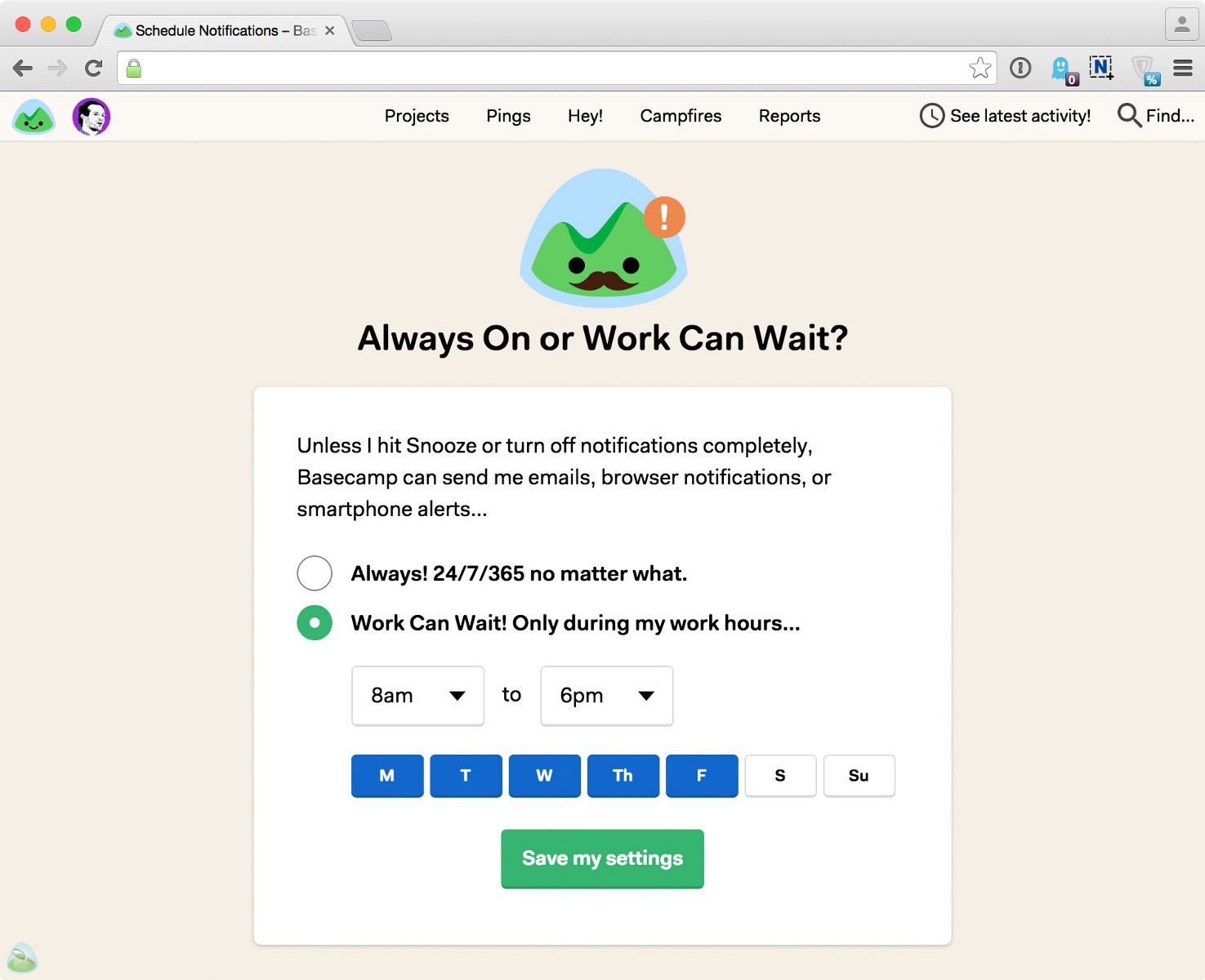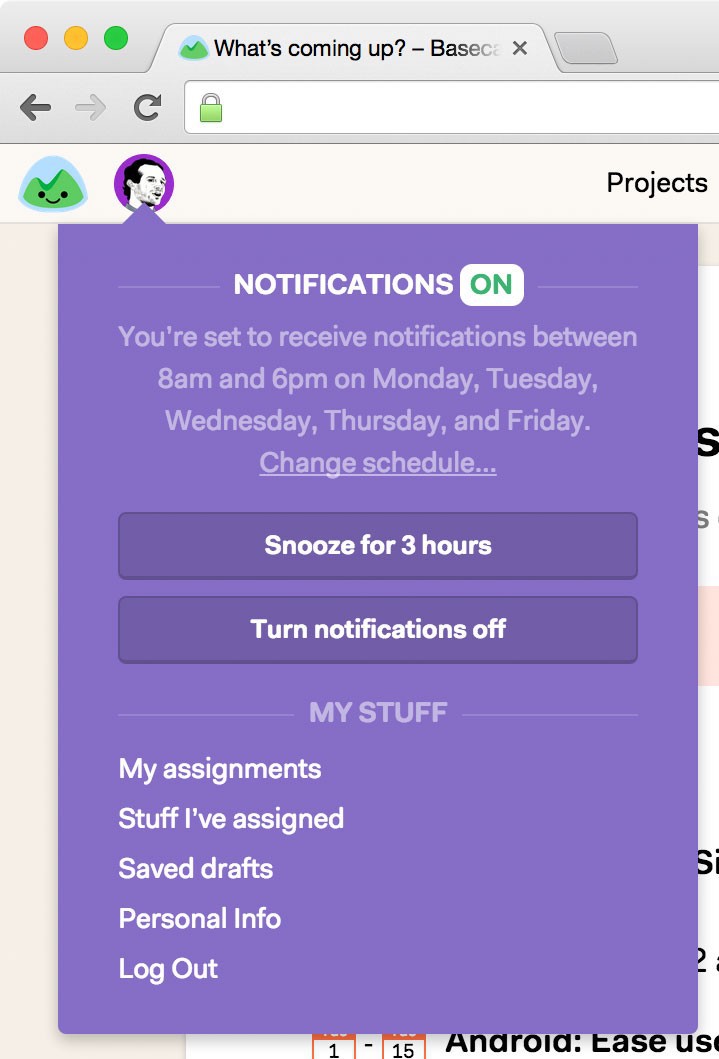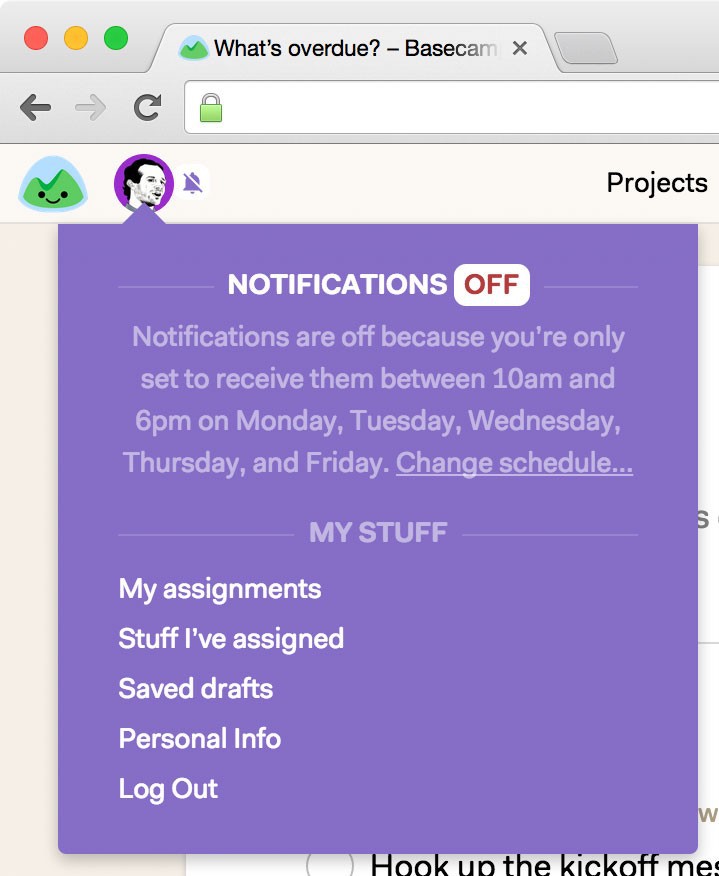Basecamp 3: Work can wait

This is the first post dedicated to the upcoming major release of Basecamp 3 (an online tool for project management, collaboration and setting project tasks, created by the company of the same name - approx. Translator ).
We have been working on the Basecamp 3 application for over a year, and some of our principles, which we are laying into the new version of the service, can be attributed to research started a couple of years ago. Now we are at the finish line and are excited before the launch of the project.
')
Over the next month, I will share some basic ideas about a completely new version of Basecamp: screenshots, design findings, strategic solutions and case studies for developing a fundamentally rethought Basecamp version with a complete redesign - the third in the last 12 years ( translations of the most interesting materials will appear on Megamind - note translator ).
The first innovation that I would like to start with is one of the key principles of the new product design: the Work Can Wait option.
If you use any modern chat, collaboration application or simple instant messenger, you probably noticed a growing tendency for people to expect your availability 24/7. For example, someone from work sends you a message on Saturday, you get a notification - what should you do? This message can be ignored, but what are the expectations of that person? His expectations can be described by the phrase "if he is available, he should be answered." And if you do not reply, you will most likely notice another message sent using the current application, or a similar message in another service - the person is trying to reach you in another way. And then there is already some pressure forcing you to respond. Saturday, Karl! Or at 9 pm on Wednesday. Or at any other time when you live your life and relax, not work.
I am not inclined to blame the communication tools for this — they simply do what the creators designed them for. But I believe that creators can build tools to help you draw the line between work and personal life. We added this pitch rule in Basecamp 3 by creating the Work Can Wait function.
Like other modern messaging tools, Basecamp 3 notifies the user about new events through push notifications, displaying them on the desktop, through a proprietary mobile application, or via email. A couple of factors influence their appearance: what do you do at a certain moment and where are you. Regardless, Basecamp is trying to get your attention when someone else is trying to get this attention.
This is normal throughout the work day. Basecamp 3 allows you to turn off notifications at any time, to give you a break of a few hours is good. But what if today, say, Monday, and now it's 8 o'clock in the evening? Or a weekend? You are unlikely to be delighted with the need to continuously turn off manual notifications. And you hardly want to turn them off and on every day - at least twice a day to keep work at a distance in an attempt to distract.
So, Basecamp 3 allows you to set a schedule for displaying notifications.

Each employee can set up their own work schedule in Basecamp 3. Of course, the option of receiving non-stop notifications is available - 24 hours 7 days a week, 365 days a year. Or you can say to the program: “Basecamp, send me notifications only during business hours.” You can then set the start and end times, as well as set which days are working days.
The screenshot above illustrates my working hours: from 8 am to 6 pm, from Monday to Friday.
During other hours Basecamp, in fact, blocks all notifications - the service automatically mutes them before the start of the working day. As soon as the clock shows 8 am, the notifications begin to appear again. Of course, I can check the alerts at any time by looking in the mobile application or using the online version of the service. However, the decision rests with me, not with the program, which sends me a notice while I walk with my son on Saturday morning.
Notifications enabled (ON):

We also implemented an option, thanks to which everyone can easily turn off notifications for several hours, turn them off completely or quickly view (change) the schedule of notifications.
Notifications off (OFF):

By clicking on your image at the top of the screen, you will see your current notification settings. In the first example, the notifications are included, because at the moment the schedule is set to 8.00 - 18.00 from Monday to Friday. If I want to change the schedule, I simply click on the Change Schedule link and switch to Always ON mode (always on) or change the hours of alert activity.
In the “on” mode, I can quickly activate the alert off mode for 3 hours (Snooze for 3 hours) or turn them off completely until I turn the notifications on again.
If notifications are disabled, the application will inform me about this and explain why I am not receiving information from the service. In this case (see the screenshot above), the alerts are inactive, because I configured to receive them from 10 am to 6 pm, and the screenshot was created at 9:23 am.
We are convinced that the Work Can Wait option is very important. 9 pm on Friday is non-working time. As well as 6am on Wednesday. It may be working for you - but not for me. And I also do not want this to be working time for my employees.
Each Basecamp 3 user, by default, starts from 8.00 am to 6.00 pm in his time zone. Of course, everyone is free to change this setting, however, it seems to us that it is important to remain true to the Work Can Wait option, and not to switch to the standard 24/7/365 notification mode from other services.
After all, even the typical “Knock me on any working issue” may eventually lead to a broken “I don’t want to work here anymore.”
Team Basecamp - for the early morning hours, evenings and weekends, free from work. And the work can wait.
Source: https://habr.com/ru/post/294446/
All Articles